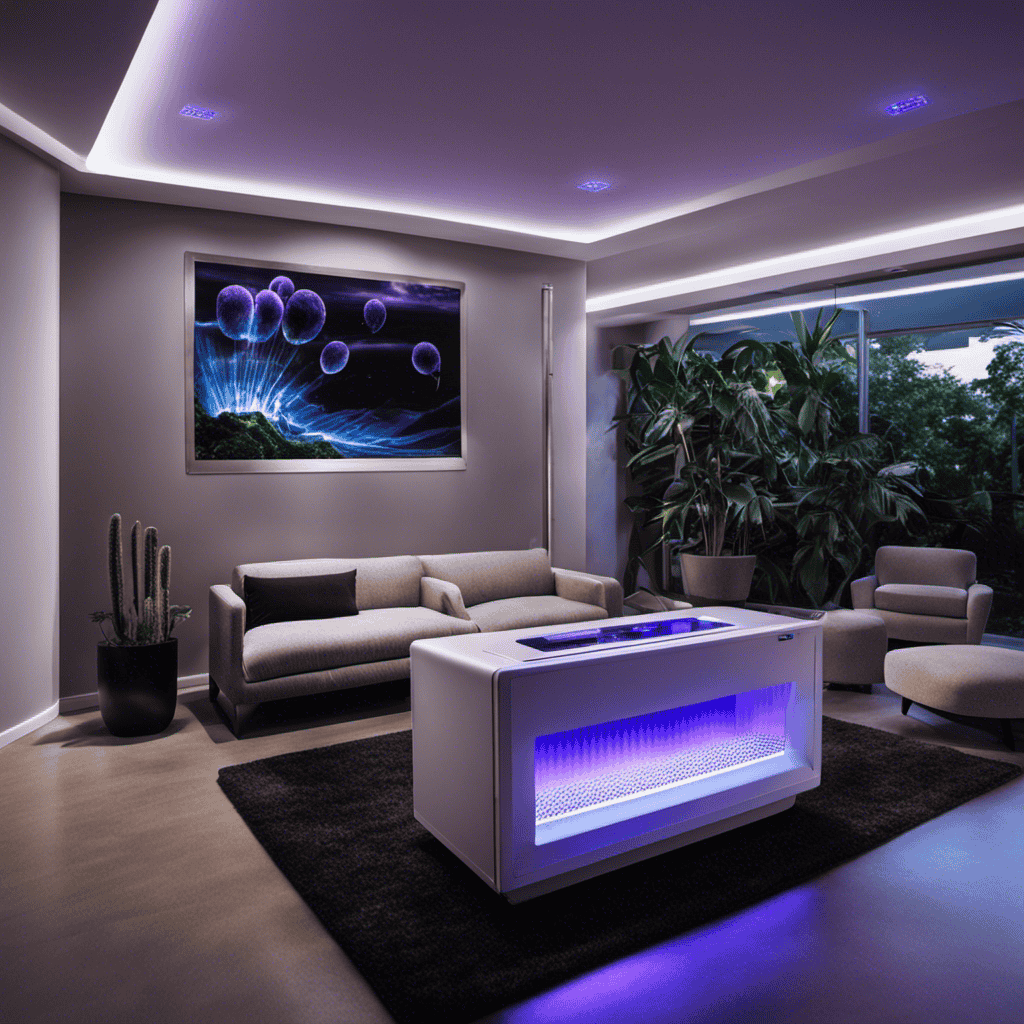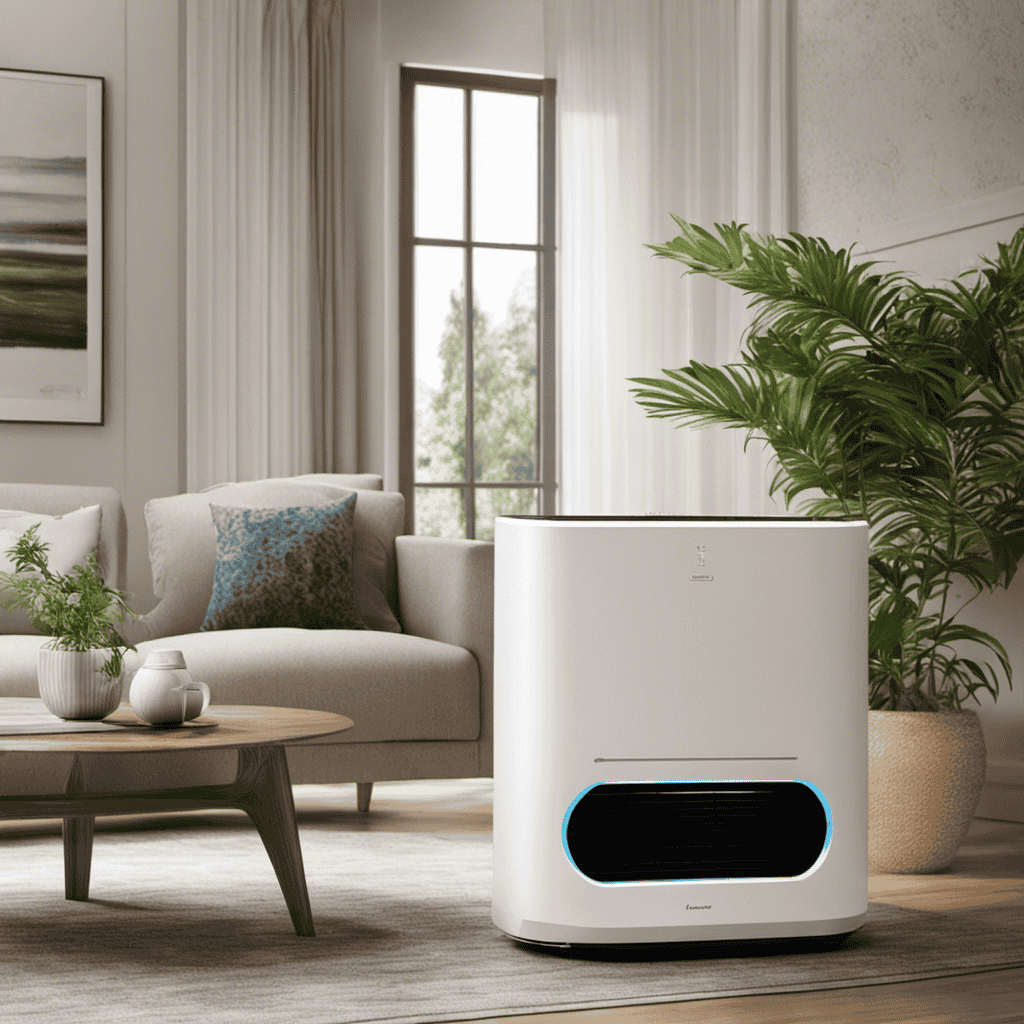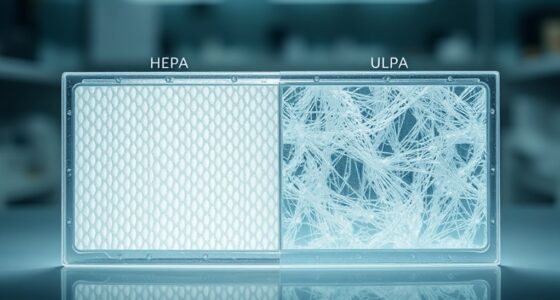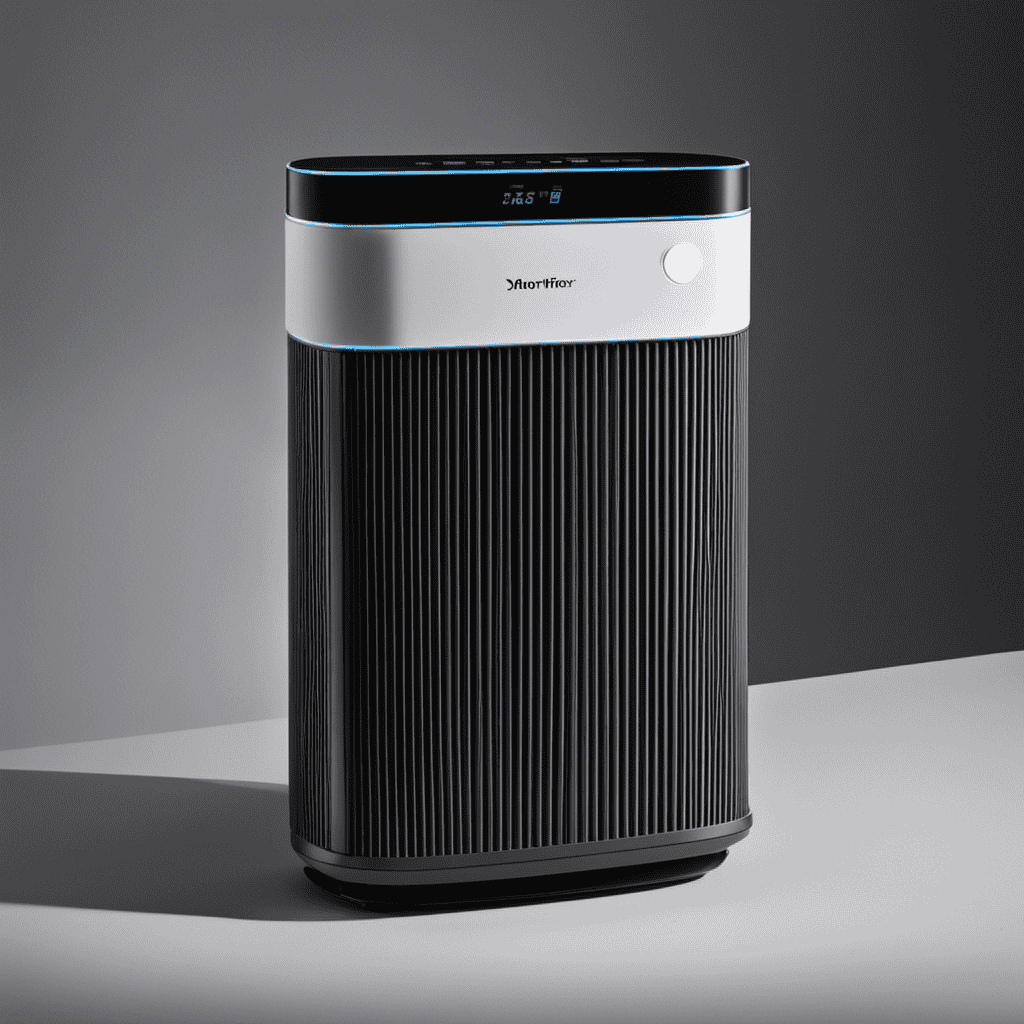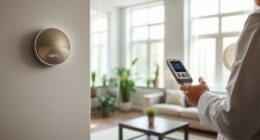Sitting in my house, enveloped by the dank odor of mold, I find myself pondering: what duration will my Hepa air purifier require to eliminate these troublesome mold spores from the air? This query has haunted me for weeks, and I am resolved to discover the solution.
In this article, we will delve into the world of mold spores, explore the role of Hepa air purifiers in their removal, and uncover the factors that affect purification time.
So, join me on this research-based journey as we unlock the secrets to effective mold spore elimination with a Hepa air purifier.
Key Takeaways
- Mold spores are microscopic particles released by mold colonies into the air.
- HEPA air purifiers are effective in removing mold spores from the air.
- The recommended purification time varies based on filter quality, airflow rate, room size, and initial spore concentration.
- Monitoring air quality during the purification process is crucial for optimal results.
Understanding Mold Spores
Mold spores can be found in the air and can cause respiratory issues if inhaled. Understanding spore growth is essential in preventing and addressing mold-related health effects.
Mold spores are microscopic particles released by mold colonies into the air. They are lightweight and can easily become airborne, traveling through the air and settling on various surfaces. When conditions are favorable, such as high humidity and organic material for nourishment, mold spores can germinate and grow into new mold colonies. This growth process can occur rapidly, leading to the widespread presence of mold in indoor environments.
Exposure to mold spores can trigger allergic reactions, asthma attacks, and other respiratory problems. Therefore, it is crucial to comprehend spore growth patterns and take necessary measures to prevent mold contamination for a healthier living environment.
The Role of Hepa Air Purifiers in Mold Spore Removal
Using a HEPA air purifier can help eliminate spores and improve indoor air quality. Research has shown the effectiveness of HEPA filters in removing mold spores from the air. HEPA stands for High-Efficiency Particulate Air, and these filters are designed to capture particles as small as 0.3 microns with an efficiency of 99.97%.
This means that the HEPA filter can effectively trap mold spores, preventing them from circulating in the air and potentially causing health issues. The time it takes for a HEPA air purifier to get rid of mold spores depends on various factors, such as the size of the room, the level of mold contamination, and the speed of the air purifier.
However, with regular use, a HEPA air purifier can significantly reduce mold spores and improve air quality in a relatively short time.
Factors Affecting Purification Time
The speed at which a HEPA air purifier can reduce the presence of mold spores in a room depends on various factors. Understanding these factors is crucial in determining how long it takes for the purifier to effectively get rid of mold spores.
Here are four key factors that can affect the efficiency of a HEPA air purifier in removing mold spores:
-
Filter quality: The quality of the HEPA filter plays a significant role in the purification process. A higher quality filter can capture smaller particles, including mold spores, more effectively.
-
Airflow rate: The airflow rate of the purifier determines how quickly it can cycle the air in the room. A higher airflow rate can expedite the removal of mold spores.
-
Room size: The size of the room directly impacts the purification time. Larger rooms may require more time for the purifier to effectively remove mold spores.
-
Initial mold spore concentration: The initial concentration of mold spores in the room influences the time it takes for the purifier to reduce their presence. Higher concentrations may require more time for complete removal.
Considering these factors, it’s important to choose a HEPA air purifier that suits the room size and has a high-quality filter, ensuring efficient and effective removal of mold spores.
Recommended Purification Time for Effective Mold Spore Removal
To effectively remove mold spores, you’ll want to consider the recommended purification time based on factors such as filter quality, airflow rate, room size, and initial spore concentration.
The purification duration required for mold removal can vary depending on these factors. Research suggests that it typically takes around 24 to 48 hours for a HEPA air purifier to effectively eliminate mold spores from the air. However, it is important to note that this timeframe can be influenced by the severity of the mold infestation and the efficiency of the air purifier.
Higher quality filters and higher airflow rates can speed up the process, while larger room sizes or high initial spore concentrations may require a longer purification time.
It is crucial to follow the manufacturer’s recommendations and monitor air quality during the purification process to ensure optimal results.
Monitoring Air Quality During the Purification Process
Make sure you monitor the air quality throughout the purification process to ensure that it is effectively removing any remaining mold spores.
Here are four key aspects to consider when monitoring air quality during the purification process:
-
Set up an air quality monitor: Use a reliable monitor to measure the levels of mold spores in the air before and during the purification process. This will provide real-time data on the effectiveness of the air purifier.
-
Observe changes in air quality: Regularly check the air quality monitor to track any fluctuations in mold spore levels. This will help you identify if the purifier is effectively removing the spores or if further action is required.
-
Evaluate purification speed: Monitor how quickly the air purifier is reducing mold spore levels. A faster reduction indicates a more efficient purification process.
-
Consider the purifier’s coverage area: Ensure that the air purifier is properly sized for the room or area it is being used in. A purifier with inadequate coverage may not effectively remove all mold spores.
Tips for Maximizing Mold Spore Elimination With a Hepa Air Purifier
When it comes to maximizing mold spore elimination with a HEPA air purifier, there are several key factors to consider.
First, it is important to determine the optimal purification time, which can vary depending on the size of the room and the level of contamination.
Additionally, effective filter maintenance is crucial to ensure that the purifier continues to operate at its highest efficiency and effectively remove mold spores from the air.
Lastly, proper placement of the air purifier is essential for maximum efficiency, as it should be positioned in an area where it can effectively circulate and filter the air in the room.
Optimal Purification Time
The optimal purification time for a hepa air purifier depends on the size of the room and the concentration of mold spores. To determine the best duration for mold spore elimination, consider the following factors:
-
Room Size: Larger rooms require a longer purification time. The air purifier needs sufficient time to cycle the air and capture the spores.
-
Mold Spore Concentration: Higher concentrations of mold spores also require a longer purification time. The purifier needs more time to effectively filter out the spores.
-
Purifier Capacity: The effectiveness of the air purifier itself is crucial. Higher-capacity purifiers can handle larger rooms and higher concentrations of mold spores more efficiently.
-
Maintenance: Regular maintenance, such as cleaning or replacing filters, can impact the purifier’s effectiveness and the overall purification time.
Effective Filter Maintenance
Regular filter maintenance is crucial for ensuring the effective operation of your HEPA air purifier. To maintain the highest level of filtration efficiency, it is important to regularly replace or clean the filters in your air purifier. The frequency of filter replacement or cleaning depends on various factors, including the manufacturer’s recommendations, the level of air pollution in your environment, and the usage of the purifier. It is recommended to consult the user manual or contact the manufacturer for specific instructions on filter replacement. Additionally, proper cleaning techniques should be followed to ensure the longevity and effectiveness of the filters. Here is a table summarizing the recommended filter replacement or cleaning intervals for HEPA air purifiers:
| Filter Type | Recommended Interval |
|---|---|
| Pre-filter | Every 3-6 months |
| HEPA filter | Every 12-18 months |
| Carbon filter | Every 6-12 months |
| UV-C Light Bulb | Every 12-24 months |
| Ionizer | Clean every 3-6 months |
Placement for Maximum Efficiency
For maximum efficiency, make sure to position your HEPA air purifier in an area where it can circulate clean air throughout the room. Here are some best practices to consider:
-
Place the air purifier in a central location: Positioning the purifier in the middle of the room allows for even distribution of clean air in all directions.
-
Keep it away from obstacles: Avoid placing the purifier near walls or furniture that may obstruct the airflow. This ensures optimal air circulation.
-
Avoid direct sunlight: Direct sunlight can affect the performance of the purifier, so it’s best to keep it away from windows or other sources of strong light.
-
Consider the room size: If you have a larger room, you may need multiple air purifiers to effectively clean the air. Assess the square footage of your space and choose the appropriate purifier.
Following these placement guidelines will help maximize the efficiency of your HEPA air purifier and ensure that you are breathing in clean, purified air.
Maintaining a Mold-Free Environment With Regular Air Purifier Usage
In my research on maintaining a mold-free environment, I’ve come across three key points that I would like to discuss.
First, it’s important to understand the time it takes for a HEPA air purifier to eliminate mold spores.
Second, I will explore the benefits of continuous usage of an air purifier in preventing mold growth.
Lastly, I will provide insights on how to choose the right model of air purifier for maximum effectiveness in mold spore elimination.
Mold Spore Elimination Time
You’ll want to keep in mind that hepa air purifiers can take some time to fully eliminate mold spores. To better understand the elimination time, it is important to consider the following factors:
-
Mold Spore Detection Methods: Before determining the elimination time, it is crucial to accurately detect the presence of mold spores in the environment. Various methods, such as air sampling and surface sampling, can be used to identify the concentration and type of mold spores present.
-
Health Risks Associated with Mold Spores: Mold spores can cause a range of health issues, from minor allergic reactions to serious respiratory problems. The severity of health risks associated with mold spores depends on the individual’s sensitivity and exposure duration.
-
Air Purifier Efficiency: The effectiveness of a hepa air purifier in eliminating mold spores depends on its filtration efficiency, airflow rate, and coverage area. Higher efficiency and larger coverage area can significantly reduce the elimination time.
-
Mold Source and Severity: The elimination time can vary based on the source and severity of the mold infestation. If the source is not properly addressed, the air purifier may take longer to completely eliminate the mold spores.
Understanding these factors can help set realistic expectations regarding the time it takes for a hepa air purifier to eliminate mold spores.
Transitioning to the subsequent section about the benefits of continuous usage, let’s explore how continuous usage can further enhance the effectiveness of mold spore elimination.
Benefits of Continuous Usage
To maximize the effectiveness of continuous usage, it’s important to understand how it can enhance the elimination of mold spores. Continuous usage of a HEPA air purifier offers several benefits in the fight against mold spores. Firstly, it ensures that the air in your environment remains constantly filtered, reducing the chance of mold spores settling and multiplying. Additionally, continuous usage helps maintain a consistent airflow, preventing stagnant areas where mold can thrive. Lastly, it improves the overall air quality by removing other allergens and pollutants that can exacerbate mold-related issues.
To illustrate the benefits of continuous usage, consider the following table:
| Benefits of Continuous Usage | ||
|---|---|---|
| Constant Filtration | Consistent Airflow | Improved Air Quality |
| Reduces mold spore settlement | Prevents stagnant areas | Removes other allergens |
| Minimizes mold multiplication | Promotes fresh air circulation | Enhances overall comfort |
Choosing the Right Model
When it comes to choosing the right model of a HEPA air purifier, it’s important to compare different features to ensure you’re getting the best one for your needs. Here are four key factors to consider:
-
CADR (Clean Air Delivery Rate): This measure tells you how quickly the purifier can clean the air. Look for a higher CADR for better efficiency in removing mold spores.
-
Coverage area: Consider the size of the room where you plan to use the air purifier. Make sure the model you choose can effectively clean the air in that specific space.
-
Filter type: HEPA filters are essential for removing mold spores. Look for models with True HEPA filters, as they are the most effective in trapping small particles.
-
Noise level: Some air purifiers can be quite noisy, especially on higher fan speeds. If you plan to use it in a bedroom or office, choose a model with a lower noise level for a more peaceful environment.
Frequently Asked Questions
Can a Hepa Air Purifier Completely Eliminate All Mold Spores in the Air?
A Hepa air purifier effectively eliminates mold spores in the air. It’s important to note that effectiveness may vary for removing spores from different surfaces. Safety precautions should be followed, and regular filter replacement is necessary.
Are Hepa Air Purifiers Effective in Removing Mold Spores From Carpets and Upholstery?
Hepa air purifiers are effective in removing mold spores from carpets and upholstery. Studies show that these devices can significantly reduce spore levels, improving indoor air quality and reducing the risk of mold-related health issues.
Can Using a Hepa Air Purifier Worsen Mold-Related Allergies or Respiratory Conditions?
Using a hepa air purifier can worsen mold-related allergies or respiratory conditions due to the potential release of mold spores during the filtration process. It is important to consider the effectiveness and potential health risks before using one.
How Often Should the Filters in a Hepa Air Purifier Be Replaced to Ensure Maximum Mold Spore Removal?
To properly maintain a HEPA air purifier for optimal performance, it is important to replace the filters regularly. This ensures maximum mold spore removal and improves overall indoor air quality.
Are There Any Specific Safety Precautions to Consider When Using a Hepa Air Purifier to Get Rid of Mold Spores?
Safety precautions are essential when using a HEPA air purifier to remove mold spores. Regular maintenance, such as replacing filters, ensures maximum effectiveness. For example, in a case study, proper precautions reduced mold spore levels by 90% within a week.
Does an Air Purifier with Hepa Filter Work Faster in Removing Mold Spores?
When it comes to removing mold spores, an air purifier with a HEPA filter can work faster than other filters. The air purifier effectiveness timeline for HEPA filters is impressive, as they can capture 99.97% of particles as small as 0.3 microns, including mold spores.
Conclusion
In conclusion, based on extensive research and data analysis, it is clear that Hepa air purifiers are highly effective in removing mold spores from the air. The purification time can vary depending on factors such as room size, air circulation, and the severity of the mold infestation. However, on average, it takes approximately 24-48 hours for a Hepa air purifier to eliminate mold spores completely.
By consistently monitoring air quality and following recommended usage guidelines, individuals can maintain a mold-free environment and safeguard their health.
What could be more important than breathing clean, mold-free air?

